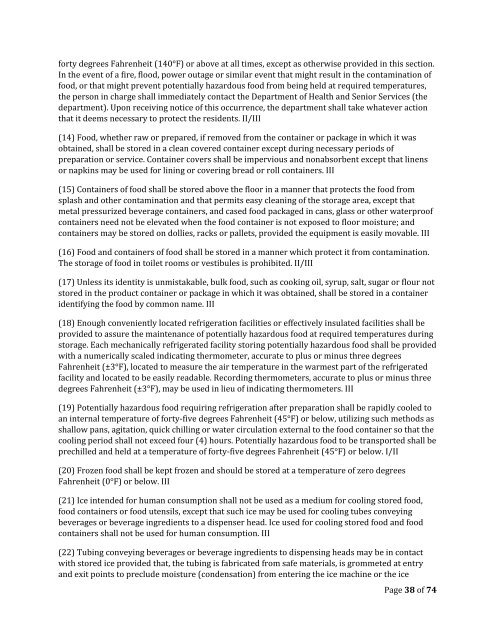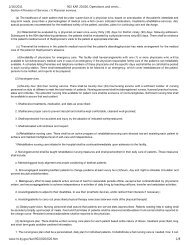State Regulations Pertaining to Dietary Sanitation & Environmental ...
State Regulations Pertaining to Dietary Sanitation & Environmental ...
State Regulations Pertaining to Dietary Sanitation & Environmental ...
Create successful ePaper yourself
Turn your PDF publications into a flip-book with our unique Google optimized e-Paper software.
forty degrees Fahrenheit (140°F) or above at all times, except as otherwise provided in this section.<br />
In the event of a fire, flood, power outage or similar event that might result in the contamination of<br />
food, or that might prevent potentially hazardous food from being held at required temperatures,<br />
the person in charge shall immediately contact the Department of Health and Senior Services (the<br />
department). Upon receiving notice of this occurrence, the department shall take whatever action<br />
that it deems necessary <strong>to</strong> protect the residents. II/III<br />
(14) Food, whether raw or prepared, if removed from the container or package in which it was<br />
obtained, shall be s<strong>to</strong>red in a clean covered container except during necessary periods of<br />
preparation or service. Container covers shall be impervious and nonabsorbent except that linens<br />
or napkins may be used for lining or covering bread or roll containers. III<br />
(15) Containers of food shall be s<strong>to</strong>red above the floor in a manner that protects the food from<br />
splash and other contamination and that permits easy cleaning of the s<strong>to</strong>rage area, except that<br />
metal pressurized beverage containers, and cased food packaged in cans, glass or other waterproof<br />
containers need not be elevated when the food container is not exposed <strong>to</strong> floor moisture; and<br />
containers may be s<strong>to</strong>red on dollies, racks or pallets, provided the equipment is easily movable. III<br />
(16) Food and containers of food shall be s<strong>to</strong>red in a manner which protect it from contamination.<br />
The s<strong>to</strong>rage of food in <strong>to</strong>ilet rooms or vestibules is prohibited. II/III<br />
(17) Unless its identity is unmistakable, bulk food, such as cooking oil, syrup, salt, sugar or flour not<br />
s<strong>to</strong>red in the product container or package in which it was obtained, shall be s<strong>to</strong>red in a container<br />
identifying the food by common name. III<br />
(18) Enough conveniently located refrigeration facilities or effectively insulated facilities shall be<br />
provided <strong>to</strong> assure the maintenance of potentially hazardous food at required temperatures during<br />
s<strong>to</strong>rage. Each mechanically refrigerated facility s<strong>to</strong>ring potentially hazardous food shall be provided<br />
with a numerically scaled indicating thermometer, accurate <strong>to</strong> plus or minus three degrees<br />
Fahrenheit (±3°F), located <strong>to</strong> measure the air temperature in the warmest part of the refrigerated<br />
facility and located <strong>to</strong> be easily readable. Recording thermometers, accurate <strong>to</strong> plus or minus three<br />
degrees Fahrenheit (±3°F), may be used in lieu of indicating thermometers. III<br />
(19) Potentially hazardous food requiring refrigeration after preparation shall be rapidly cooled <strong>to</strong><br />
an internal temperature of forty-five degrees Fahrenheit (45°F) or below, utilizing such methods as<br />
shallow pans, agitation, quick chilling or water circulation external <strong>to</strong> the food container so that the<br />
cooling period shall not exceed four (4) hours. Potentially hazardous food <strong>to</strong> be transported shall be<br />
prechilled and held at a temperature of forty-five degrees Fahrenheit (45°F) or below. I/II<br />
(20) Frozen food shall be kept frozen and should be s<strong>to</strong>red at a temperature of zero degrees<br />
Fahrenheit (0°F) or below. III<br />
(21) Ice intended for human consumption shall not be used as a medium for cooling s<strong>to</strong>red food,<br />
food containers or food utensils, except that such ice may be used for cooling tubes conveying<br />
beverages or beverage ingredients <strong>to</strong> a dispenser head. Ice used for cooling s<strong>to</strong>red food and food<br />
containers shall not be used for human consumption. III<br />
(22) Tubing conveying beverages or beverage ingredients <strong>to</strong> dispensing heads may be in contact<br />
with s<strong>to</strong>red ice provided that, the tubing is fabricated from safe materials, is grommeted at entry<br />
and exit points <strong>to</strong> preclude moisture (condensation) from entering the ice machine or the ice<br />
Page 38 of 74



